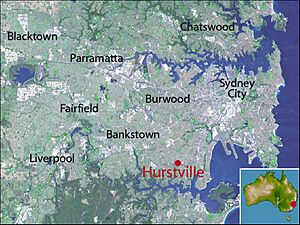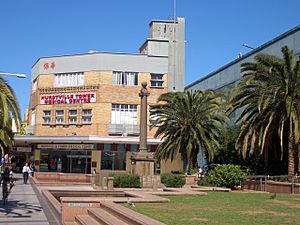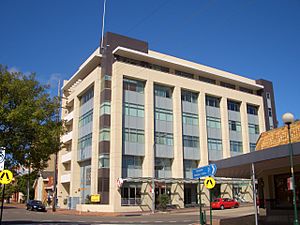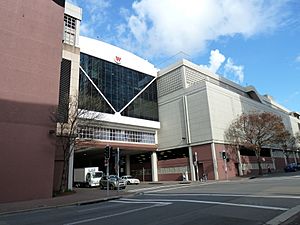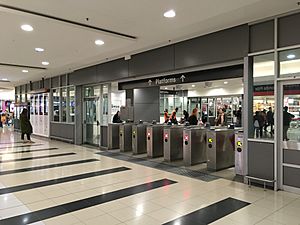Hurstville, New South Wales facts for kids
Quick facts for kids HurstvilleSydney, New South Wales |
|||||||||||||||
|---|---|---|---|---|---|---|---|---|---|---|---|---|---|---|---|
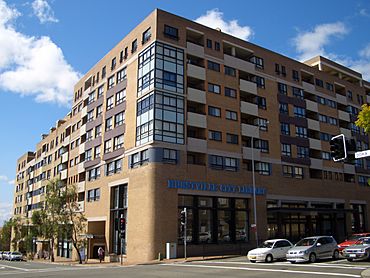
Hurstville Library
|
|||||||||||||||
| Population | 31,162 (2021 census) | ||||||||||||||
| • Density | 7,420/km2 (19,200/sq mi) | ||||||||||||||
| Established | 1887 | ||||||||||||||
| Postcode(s) | 2220 | ||||||||||||||
| Elevation | 75 m (246 ft) | ||||||||||||||
| Area | 4.2 km2 (1.6 sq mi) | ||||||||||||||
| Location | 16 km (10 mi) south of Sydney CBD | ||||||||||||||
| LGA(s) | Georges River Council | ||||||||||||||
| State electorate(s) |
|
||||||||||||||
| Federal Division(s) | |||||||||||||||
|
|||||||||||||||
Hurstville is a lively suburb in Southern Sydney, New South Wales, Australia. It's about 16 kilometers south of Sydney's city center, known as the Sydney CBD. Hurstville is a key part of the St George area and is where the Georges River Council has its main offices.
This suburb is famous for its diverse community, with many people from Asian backgrounds. In fact, about 63% of the population has Asian roots, which is one of the highest percentages in Australia. Some people even call it "Sydney's Real Chinatown" because a large number of residents, around 37%, have moved here from mainland China.
Contents
Hurstville's Past
The name Hurstville comes from two old English words. 'Hurst' means 'a wooded hill', and 'ville' means 'town'. So, Hurstville means 'town in a wooded area'.
First People of Hurstville
The first people to live in the Hurstville area were Indigenous Australians. We don't know exactly when they first settled here. When the First Fleet arrived in 1788, the Eora tribe lived in this region. Their lands stretched along the Georges River, from Botany Bay to what is now Liverpool.
European Arrivals
The first time Europeans met the Eora tribe in this area was on January 20, 1788. This meeting happened near Lugarno and Oatley, by Lime Kiln Bay on the Georges River. Lieutenant Philip Gidley King wrote about it in his diary.
Later, in 1808, the government gave land in the Hurstville region to two brothers, Captain John Townson and Robert Townson. Captain John Townson received a large area that is now Hurstville and part of Bexley. Robert Townson got land that is now Penshurst, Mortdale, and parts of Peakhurst.
The Townson brothers weren't happy with the land because it wasn't good for farming sheep. It's likely they never even lived there. In 1812, a rich merchant named Simeon Lord bought Captain John Townson's land. He called it Lord's Forest. After Lord passed away, the land was owned by John Rose Holden and James Holt from the Bank of NSW.
Sproule Family Homes
Gladwyn is a historic house on Queens Road, built in 1893. John Sproule, a local builder and council member, built it. The house changed owners many times and was known as Gladwyn by 1906. The Hurstville Council bought it in 1986. It has been fixed up and is now used for businesses and as a research center for local history.
Another house, Yarra-Mundi, was built by John Sproule in 1897. He lived there until 1904. This house also changed hands many times. In 1981, the Danebank Church of England School for Girls bought it. The school later sold it in 2003, and it was also changed for business use. Both Gladwyn and Yarra-Mundi are important heritage sites.
Hurstville's Growth
In 1839, a dam was built on the Cooks River at Tempe. By 1843, a road, now known as Forest Road, was extended from the dam to a ferry crossing in Lugarno. This new road helped open up the Hurstville area.
In 1850, Michael Gannon bought the Lord Forest estate. He divided it into smaller farms, and the area became known as Gannon's Forest. The Gannon's Forest post office opened in 1881. The local school, started in 1876, was named "Hurstville." When the railway station opened on October 15, 1884, it also took the name Hurstville from the school.
Hurstville became its own municipality in 1887. In 1988, it was officially declared a city. The Centenary Bakery on Forest Road is an old building that has been kept and once held a museum. Today, the St George Regional Museum is in another historic building on MacMahon Street.
Hurstville has a mix of homes, from single houses to medium-sized apartment buildings and tall high-rise apartments.
Hurstville's Economy
Hurstville is the main business area for the St George region. It's a big, diverse suburb with many office buildings and tall residential towers.
The main shopping and business area is on Forest Road, north of Hurstville railway station. Forest Road is a busy street with many shops, banks like Commonwealth, ANZ, National Australia Bank, Westpac, St George, HSBC, and Bank of China, and other financial places. The business area also spreads to nearby streets, especially around Queens Road and The Avenue.
Shopping and Retail
Hurstville has two main shopping centers: Westfield Hurstville and Hurstville Central. There are also smaller shopping spots like Hurstville Times Plaza and East Quarter.
Restaurants and Cafes
Hurstville is a great place to eat out, with many different restaurants and cafes. It's known as a major dining spot in the St George area. You can find a large number of Chinese (including Cantonese), Japanese, and Vietnamese restaurants and eateries here.
Other Local Services
The main offices for the Georges River Council are in the Hurstville Civic Centre on MacMahon Street. This street also has several historic buildings, like the Friendly Pharmacy, the old Fire Station, the Ritz Hotel, and the Hurstville Museum & Gallery. The Hurstville City Library is also nearby on Queens Road.
Hurstville's Culture
The St Clair Recording Studio was open for about a year from 1965 to 1966. Famous bands like the Bee Gees recorded music there. The rock band AC/DC also played at the Hurstville Civic Centre several times between 1974 and 1977.
In 2011, the first karaoke place opened in Hurstville near the Meridian Hotel.
The Hurstville Museum & Gallery focuses on the area's history, art, and culture. It has interesting exhibitions, public programs, and a collection of about 5,000 objects and artworks from the local area.
Getting Around Hurstville
Hurstville railway station is a very important station. It's on the T4 Eastern Suburbs & Illawarra Line for Sydney Trains and the South Coast Line for NSW TrainLink. All suburban and intercity trains stop at Hurstville. You can get to Sydney Central railway station in about 20 minutes on an express train.
Hurstville is also a big bus hub, with buses leaving from Forest Road and Ormonde Parade. There's also a special transport service called St George Community Transport for older people, people with disabilities, and their carers.
Places of Worship
- St George's Hurstville Anglican Church
- St Michael's Roman Catholic Church
- Hurstville Presbyterian Church
- Hurstville Church of Christ
- Hurstville Uniting Church
- Hurstville Seventh-day Adventist Church
- Hurstville Assemblies of God
- Salvation Army
- Church of the Living God
Schools in Hurstville
- Hurstville Adventist School
- Hurstville Boys High School
- Hurstville Public School
- Hurstville South Public School
- Danebank Anglican Girls School
- Hurstville Grove Infants School
- Beverly Hills Public School
- St George Christian School
- Some schools like Sydney Technical High School, Bethany College, and St. Mary's Star of the Sea Catholic Primary School are just over the border in Bexley.
Hurstville's Population
| Historical population | ||
|---|---|---|
| Year | Pop. | ±% |
| 2001 | 20,371 | — |
| 2006 | 23,331 | +14.5% |
| 2011 | 26,040 | +11.6% |
| 2016 | 29,822 | +14.5% |
| 2021 | 31,162 | +4.5% |
The first European settlers in Hurstville were mostly from Britain and Ireland. From the late 1960s, people from all over the world started moving to Hurstville. The first group included people from Greece and Italy.
From the 1990s onwards, the Chinese community in Hurstville grew a lot. This was partly due to many people moving from Hong Kong in the 1990s and from mainland China in the 2000s. Many local businesses are run by people of Chinese background. Hurstville is now a central place for Asian grocery stores, food, and services.
According to the 2016 Australian Bureau of Statistics Census, there were 29,822 people living in Hurstville. About 27.8% were born in Australia. The most common countries of birth for others were China (36.9%), Nepal (7.1%), and Hong Kong (4.0%).
Only 18.1% of people spoke only English at home. Other common languages included Mandarin (32.3%), Cantonese (17.9%), and Nepali (7.2%). For religion, the most common answer was No Religion (42.7%). The most common ancestries were Chinese (49.4%), English (6.6%), and Nepalese (6.6%).
Famous People from Hurstville
- Cecil Abbott – a former Commissioner of the New South Wales Police.
- Jack Brabham – a three-time Formula One World Champion motor racer.
- Jayden Brailey – a rugby league player for the Newcastle Knights.
- Matthew Dufty – a rugby league player for the Warrington Wolves.
- Stella Maria Sarah Miles Franklin – a famous Australian writer.
- Neville Hayes – a swimmer.
- Kerry O'Keeffe – a test cricketer and sports commentator.
- Kurtis Patterson – a test cricketer.
- Riley Price – a rugby league player for the North Queensland Cowboys.
- Ken Rosewall – a famous tennis player.
- Michael Rush – a champion rower.
Images for kids


